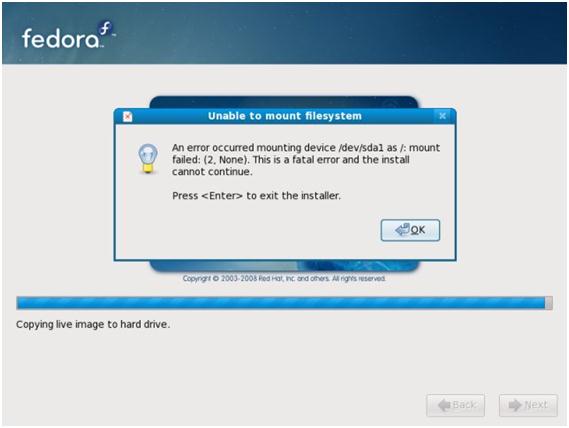Installation Failed Unable To Mount Boot Partition Wiki

File system fragmentation occurs when unused space or single files are not contiguous. As a file system is used, files are created, modified and deleted.
Before you begin. Please read Prerequisites to check if your hardware is capable of running OpenMediaVault Download an installation image file for your system. Raspbian Installer. The files used to perform the install described below can be obtained from the zip file at this link: rpi
Solving NFS Mounts at Boot Time(Today’s post is brought to you by the letters N, F, and S. Oh, and Scott Pack too.)Let’s face it. NFS is a magical thing. It allows you to centralize your storage, share volumes across systems, and all while maintaining sane permissions and ownership. Unfortunately, it can also be a bit of a fickle beast. Let’s say you just had your volume configured and you set up the mounts. You go and run this command: mount - t nfs 1.
Works like a champ, you now have your data partition mounted over NFS. So you add this line to your /etc/fstab and make it mount automagically.
A few weeks go by and you apply a kernel update. No big deal, you apply the updates and during your next maintenance window reboot to apply the new kernel. Then you start to see applications failing and notice the volume isn’t actually mounted. This is an unfortunate result of the automounter subsystem. It’s like this. At boot time the root partition gets mounted, automounter reads the /etc/fstab file, and boots any filesystem that doesn’t have noauto as a mount option. We’re still very early in the boot process so the network isn’t up yet, so naturally any network filesystems fail. The real problem here is that at no point does automounter go back and attempt to remount those systems.
So your NFS mount points fail because there is no network, and done is done. The developers were nice enough to provide a fix for this. There exists a mount option called . How To Uninstall Rpm Packages In Centos Linux. If we quote directly from the man page (sourced from RHEL 6. So you modify your entry in fstab to look like this: 1. After the system comes up you notice a problem. Your NFS volumes are still unmounted.
You see, there’s a bit of a hitch. Automounter followed the same procedure that it did before, except this time it didn’t even attempt to mount /data. There is still a missing piece to the puzzle. Free Download Cash Flow Quadrant Bahasa Indonesia. If you look at your init scripts there is a service called netfs. If you read the script you can see in the chkconfig header this description: # description: Mounts and unmounts all Network File System (NFS),# CIFS (Lan Manager/Windows), and NCP (Net.
Ware) mount points. This is exactly what you need. It is a service whose sole purpose is to read your /etc/fstab and mount network filesystems. All you have to do is enable itchkconfig netfs onand watch the magic happen. Now your mount boot process should look something like this: Automounter reads /etc/fstab. Ignores /data since it has . I had even gone so far as to start planning out my own custom init script that would do exactly this, except specifically for my mount points instead of generalizing.
It’s nice to see that I was on the right track, but even better that the tools already existed.